
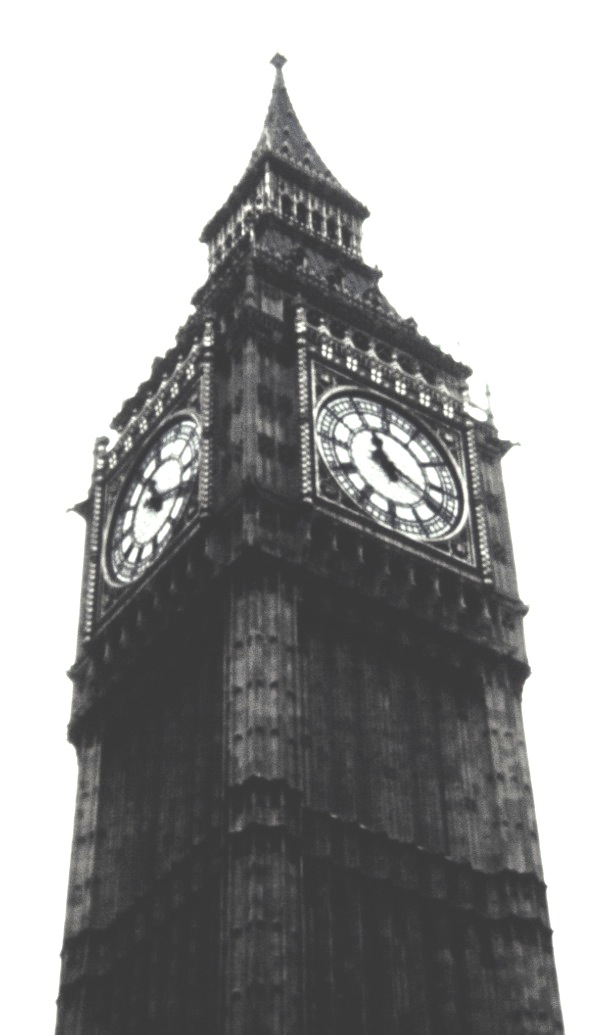
The bell of the Westminster clock weighed just over 4 tons and was one of three ordered by King Edward III from (apply named) John Belleyetere. The charge in the Pipe Roll 41 of 1366-7 was £246-l6s.-8d.
The clock was replaced by a new one by Agnes Dalavan in 1427. (An early example of a lady clockmaker, and not the only one).
A large part of Westminster palace burned down in 1512. Just after King Henry VIII and Queen Katherine had moved in. They moved to Wolsey's residence of York House which was nearby. Wolsey did not own it, he was occupying it as he was Archbishop of York. That did not stop Henry VIII from taking it over permanently, and rebuilding it. He did this regardless of the neighbours. A people were living nearby were upset and angry at the road, their houses and their shops being destroyed to make York House more palatial. The palace was later called Whitehall.

Westminster Palace had been rebuilt but was no longer used by the King as his residence. It was now used only for Parliament meetings and government offices. As part of the rebuilding, in 1530, the clock was renovated, and its four clock faces were painted and re-guilded.
At that time Parliament, especially the House of Commons, could meet anywhere in the neighbourhood. Much of their business was done in local pubs. Before the 16th century, the Commons might meet up anywhere convenient and that could be anywhere in the country, but they usually met near Westminster by the time Henry VIII was King.
In 1547, King Edward VI (then only 9) gave the House of Commons, St. Stephen's Chapel, in Westminster Palace as their permanent meeting place. (Did not really stop the secret meetings in pubs). Both the Lords and the Commons were now usually meeting at the same time and nearby which enabled more communication.
All the business at Parliament was wound up officially and ceremonially on the last afternoon of the sessian, by the King (after a big midday dinner with chosen Lords). The Commons Members of Parliament were brought in to stand at the back. Both the MPs and Lords, hoped to get the session finished by summer so they could leave London for the fresh air of the countryside and hopefully escape the plague and other epidemics the hot weather brought to the crowded city. Hence the tradition of the long summer break.
By the end of the 17th century, the clock tower was in a decrepit condition, and in 1698, it was demolished. The bell, the Great Edward, was given to St. Margarets church, and the churchwardens there sold it to the Dean and Chapter of St.Paul's cathedral, to have it re-cast for their new clock.
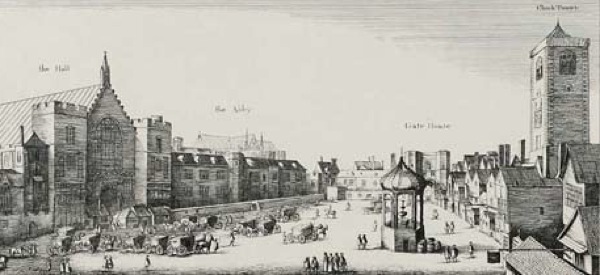
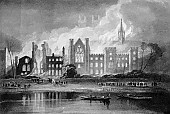
In 1834, most of the Palace of Westminster was yet again destroyed by a fire. The masses of stored accounts, much of it in the form of wooden tally sticks, had lent fuel to the flames. Little could be saved.
However, at the time, such a loss was unlamented. The Palace had long been an untidy patched-up mess of buildings, and some of the more recent constructions had been likened in style to a Gentlemen's lavatory.
A Board of Commissioners was set up to hold a competition for the best design for the new Palace. To keep the flavour of the historic building of which (once again) only St. Stephens chapel remained, the style had to be "Elizabethan" or "Gothic".
The winner, though, was Charles Barry, known to favour the classical style of architecture. Here is his design:
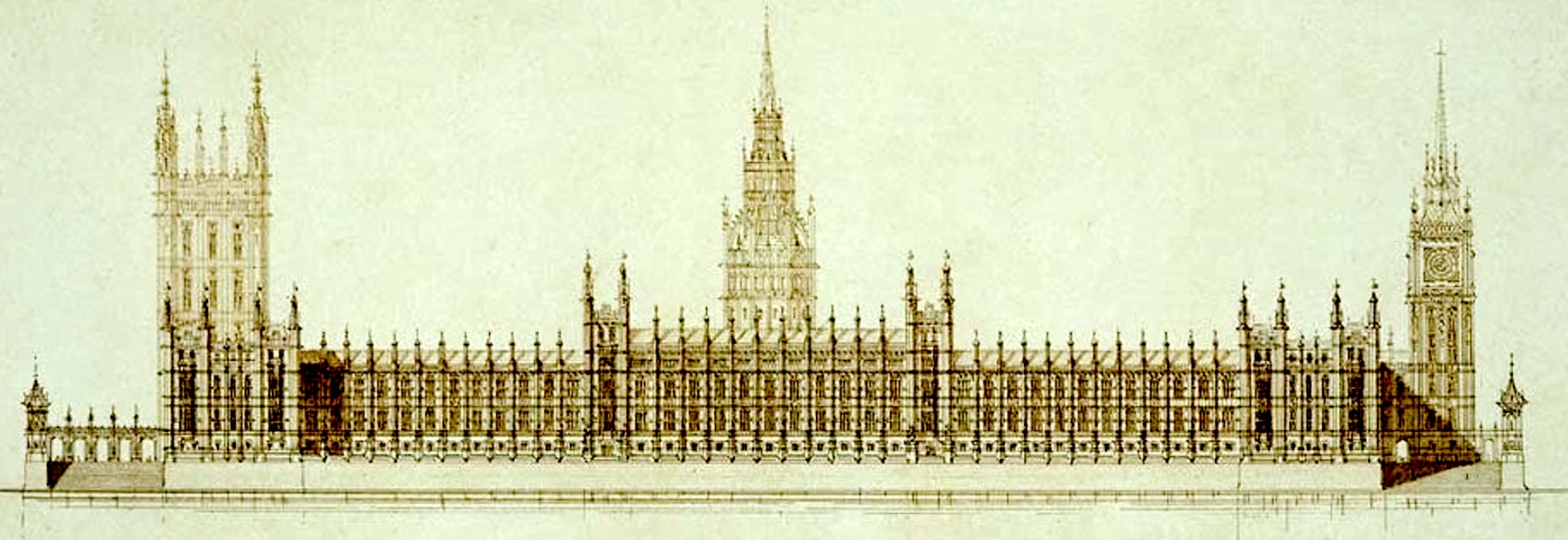
Disappointed contestants pointed out that Barry was known to be a close friend of the Chief.
Commissioner of the Board. They were further incensed when Barry's designs were considerably altered, after they had been selected.
One of these new alterations, was the addition of a clock tower.
The Contractors, Grissell and Peto, began work on the Clock Tower in 1843.
They started with immense problems. Being situated in marshy ground next to the Thames, the ground was liquid mud. So they had to start the building by driving piles into the soggy ground to make a kind of coffer-dam for the deep hole they dug.
There was a workman's cafe on the edge of the hole they dug, called Oliver's Coffee House. It was a home as well as business, to Mr. Oliver Mansfield and his family.
One night at 10 o'clock, the cafe toppled over into the hole and sank slowly into the slime. Fortunately, the proprietor, Mr. Oliver Mansfield and his family all managed to escape, but they were left with nothing but the nightclothes they had been wearing. A court enquiry was held, and they were eventually awarded compensation for the loss of their home, shop and possessions, of £246,700.
The tower was built without scaffolding, a method Barry copied from the tower of Strasbourg cathedral. Materials were raised with a steam hoist up the inside of the tower.
Now the tower was under way, the architect had to find a clockmaker for the clock to go in it. In the file on the clock (PRO Works 11/134), a letter dated 29th March 1844, from Charles Barry to Benjamin Vulliamy, Master of the Company of Clockmakers, requests:
"I shall be obliged by your informing me whether you would be disposed to funish me with a plan for the Clock which will be required for the New Palace of Westminster. I propose that the Clock should strike the hours on a Bell of from 8 to 10 ton and if practicable chime the quarters upon 8 Bells and shew the time upon 4 Dials about 30 feet in Diameter."
"The clock I should propose as fit for the purpose would be very much the most powerful eight day clock ever made in this country."
The construction of the Westminster Clock, attracted the attention of the Astronomer Royal, George Biddell Airy.
Airy wanted Edward John Dent, a chronometer maufacturer, who recently constructed the large turret clock on the Royal Exchange, to make the Westminster clock. This clock was to be the Clock for Parliament, the centre of the Nation, the centre of the Empire. It had to be special. Airy believed the clock Dent had made for the Royal exchange "to be the best in the world as regards accuracy of going and of striking." Airy specified that the clock was to be kept as near as possible to Greenwich Time, within one second.
Dent duly tendered his contract to the Lords Commissioners of Woods and Forests (seems odd, but this was to be replaced by the Board of Works). The First Commissioner of the Office of Woods and Forests, Viscount Canning, decided that it would be best to hold a public competition to decide who should made the clock. The conditions were laid down by Airy.
Three clock makers were expected to compete. Besides Vulliamy and Dent, there was John Whitehurst of Derby. Whitehurst proposed the clock to be regulated in the latest modern way, by electricity, and described his plan to Airy:
"I have constructed a separate piece of clock work to be appened to the Great Clock for the new Houses of Parliament to break contact with a powerful magnet once every minute to regulate the other clocks in the new palace on the principle recommended by Mr. Wheatstone."
The first electric clocks had appeared just before 1840, simultanously with the electric telegraph. Both inventions were were based on the discovery that electric current deflects a magnetic needle (or pendulum). The system of an electric clock driving slave clocks, invented by Professor Charles Wheatstone of King's College, London University (better known as the inventor of the electric telegraph and the concertina) was too inaccurate and inefficient to be of use at the time. Moreover, until the development of the electric generator, an electric clock and its slave clocks on the scale needed at the Palace of Westminster, would seem to be an impractical proposition, because of the bulkiness of the battery needed to produce sufficient electric current.
So Airy replied to Whithurst:
"The question of attaching apparatus for effecting the regulation of other clocks by a magneto-galvanic current, must, for the present, be kept open. The experiments which I have made lead me to doubt the practicability of this plan. There is no doubt that the regulation would be effected with perfect ease by means of a galvanic battery, but this is attended with various inconveniences."
"The transmission of a signal to Greenwich by a magneto-galvanic current is a matter of no difficulty, and I recommend that preparation be made for it."
The clock was to be checked by telegraph with Greenwich twice daily.
Edward Dent also discussed the construction of the clock with Airy. He went to France to study the latest turret clocks there, including those using electricity to regulate the movement of the pandulum.
Vulliamy refused to comply with Airy's specifications. And Barry had to accept that the cheapest estimate should be accepted, and this was Dent's.
Vulliamy was so annoyed that he tried to claim payment for the work he had put into the designs he had done. These drawings are in the library of the Institute of Civil Englineers.
Because Barry had really wanted Vulliamy to do the work, he refused to co-operate and work with Dent.
The clock tower was nowhere near finished. Building had been held up from lack of funds. Since the Revolutions in Europe of 1848, the Government was pouring its money into Defence. The Contractors, Grissell and Peto, were replaced by John Jay, because this firm was cheaper.
Sir Charles Barry, could not even get into the clock tower to check on its progress, because he had quarrelled with the ventilating engineer, who since the tower had been incorporated into his ventilating system had a proscriptive right to the tower. And could dictate who he allowed into it.
Dr. David Boswell Reid, the Ventilating Engineer known as: "Reid the Ventilator", had a very neccessary (though not always very pleasant) task.
The increasing manufacture, installation and use of water closets (the toilets we use today) had greatly improved hygiene in homes and offices. Unfortunately from these shiny hygenic new loos, the effluent went straight down the drains into the same old smelly sewers which had originally only been built to cope with rainwater. Now it was the very smelly raw sewage full of toxic germs, that was discharged straight into the Thames.
The outlet for the excrement of all Westminster, Victoria and Pimlico was by Westminster Bridge, right outside the Houses of Parliament. On a warm day, the stench from the Thames, combined with the effluvia of the horse dung trodden in from the yard, caused members to keel over and debates to be abandoned.
Reid carried out a number of experiments to find a solution to this problem. One such experiment in 1841, was with two sides of fresh beef. One piece of meat, Reid left on a platform 10 feet from the ground in the open air beside the river, just outside the House of Lords. The other was exposed on a platform 40 feet high. The meat at the lower level had gone bad within 24 hours. The other piece remained fresh for three days. Reid concluded that the higher the air, the purer it was.
Accordingly Reid decided to fit an intake pipe into the Victoria Tower, and the Clock Tower, suck fresh air down from the upper atmosphere into the two debating chambers, then have the stale air sucked out and expelled back into the upper atmosphere through a central lantern.
This central lantern had no part in Barry's original plans and Barry was furious that Reid should impose a new feature on his design. He also objected to the space Reid was taking up with his pipework. Reid alleged that Barry had:
"actually blocked up by Brick work the principal Channels of Supply of fresh Air from the Clock Tower to the New House of Commons"
The argument was conducted via the Board of Woods and Forests, causing that body to comment to Reid that it was "extremely objectionable that the Official Correspondence with Them should be made the medium of indulging in personal invectives."
Sir Charles Barry was also involved in an argument with the consulting engineer to the Metropolitan Sewers Commission, Henry Austin (brother of Jane Austin the novelist).
Austin criticised the sewers at Westminster which were large and brick-built in the usual form at that time.
By 1848, developments in sanitary engineering had produced a glazed earthenware pipe that could be more efficiently flushed clean.
To reinforce his point, Austin left open a trap below the clock tower, thus filling the Division Lobbies with an evil miasma. Barry put the blame on Reid.
The clock tower was turned into another ventilation outlet, but Reid's system never worked properly. Not having electric fans, Reid had to rely on opening hatches to create current. (As was done at the time by small children down mines).
In 1852, Reid the Ventilator got the sack. He emigrated to the USA. His place as Ventilation Engineer was taken by a Cornish doctor, Goldsworthy Gurney, inventor of among other things, a steam car.
In a report made to the Commissioner of Works in 1857, Goldsworthy Gurney supported Henry Austin, by stating:
"The sewers are the same in every respect now as they were before water closets were in use; no change had been made to meet the altered requirements. The sewage gases are discharged in large quantities from the open mouths of the sewers along the sides of the river, seriously affecting the atmosphere of the Houses of Parliament."
Although bacteria had been discovered, the connection these tiny life forms, visible only with a microscrope, had with disease was still controversial. Curtains soaked in chloride of lime, a disinfectant as well as a deodorant, were put up at the windows of the chambers to keep out the pong, and freshen the air, but even this was not always effective enough. Gurney said:
"For a long time offensive smells were complained of in the courts of law at Westminster, and on one occasion, the judges were driven from their benches by a sudden outbreak of stench, which also reached the Houses of Parliament."
London's air was bad, especially in summer. But it was to get really bad in 1858. 1858 has gone down in history as "The Year of the Great Stink". In the summer of 1858, dry, hot weather concentrated the excrement and rubbish clogging up the river and streams and sewers, and there was not nearly enough rain to dilute and wash the smelly muck out and down the Thames to the sea.
The atmosphere in the the Houses of Parliament on the banks of the Thames, combined with the Cholera epidemics of 1831, 1848, and 1854 - when a quarter of a million people died of Cholera - and in 1866, finally forced the government to do something about Public Health and Sanitation.
In a letter to The Times, which was included in the Report of the Committee for Scientific inqiries in relation to the Cholera Epidemic of 1854, Professor Michael Faraday describes a boat trip he bravely took down the Thames, and reported: "Near the bridges the feculence rolled up in clouds so dense that they were visible at the surface, even in water of this kind."
Although the tides washed the sewage and rubbish in the Thames out to sea, they also washed it back again to London.
Gurney had first hand experience of the dangers of the smelly poisonous gas in the sewers. He had been called to perform autopsies and give evidence at an inquest into the death of five men in the main Victoria sewer, not far from the Houses of Parliament. Two men had been sent in to clear it out, and when they did not emerge, two colleagues went to find them, and when they failed to come out, a policeman went down to see what had happened - he did not come out again either. When a shaft was opened to find the men, and release the gas, a flame leapt 20 feet into the air.
This was not the only incident where sewer gas had caused deaths.
Gurney had a plan to ventilate the sewers near the Houses of Parliament. (At least the MPs and Lords would no longer suffer the bad pong from the Thames). Gurney's plan was that the ventilation shaft inside the Westminster clock tower, should not only draw up the stale air from the Houses of Parliament, but the evil gases from the main Victoria sewer which served Westminster and Pimlico, and drained into the Thames by Westminster Bridge.
Not everyone realises that Britain's iconic symbol, the Westminster Clock, not only serves as national timekeeper but as a sewer ventilation chimney.
Then in 1853, Edward Dent died. His stepson Frederick Rippon, now called himself Dent under the terms of his stepfather's Will, and took over the contract for the Westminster clock. His name is engraved in guilded letters on the clock works. However at the time he had a great deal of difficulty in getting the government to accept him as the new clockmaker.
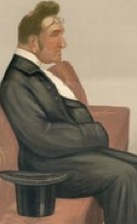 The Board of Works did not only have Frederick Dent to deal with. They, Barry, and Airy, now found themselves up against the clock designer - a lawyer, Edmund Beckett Denison. (Later Lord Grimthorpe).
The Board of Works did not only have Frederick Dent to deal with. They, Barry, and Airy, now found themselves up against the clock designer - a lawyer, Edmund Beckett Denison. (Later Lord Grimthorpe).
As a lawyer as well as clockmaker, Denison was called as referee on the clock, together with Airy. And he took control of the alcoholic Frederick Dent. Denison described the work on the Westminster Clock in his popular and still printed work: "Clocks, Watches and Bells". The first edition, on clocks and watches, had been published in 1850. Denison imposed forcefully, his ideas and opinions on the building of the clock and engaged in 16 years of acrionious discussion about this, including a libel action, Stainbank v. Beckett about the soundness of the hour bell (Big Ben), which he lost.
When Frederick Dent was dying, in 1860, Denison persuaded him to make his will in favour of Denison, passing over his mother and sisters, who were in far more need of any money left. This caused a public scandal.
Early in 1852, Denison and Airy, submitted specifications and drawings of the clock works.
It had been decided to have an hour bell of 14 tons, and 4 quarter bells. The famous chimes were copied from those of St. Mary's Cambridge.
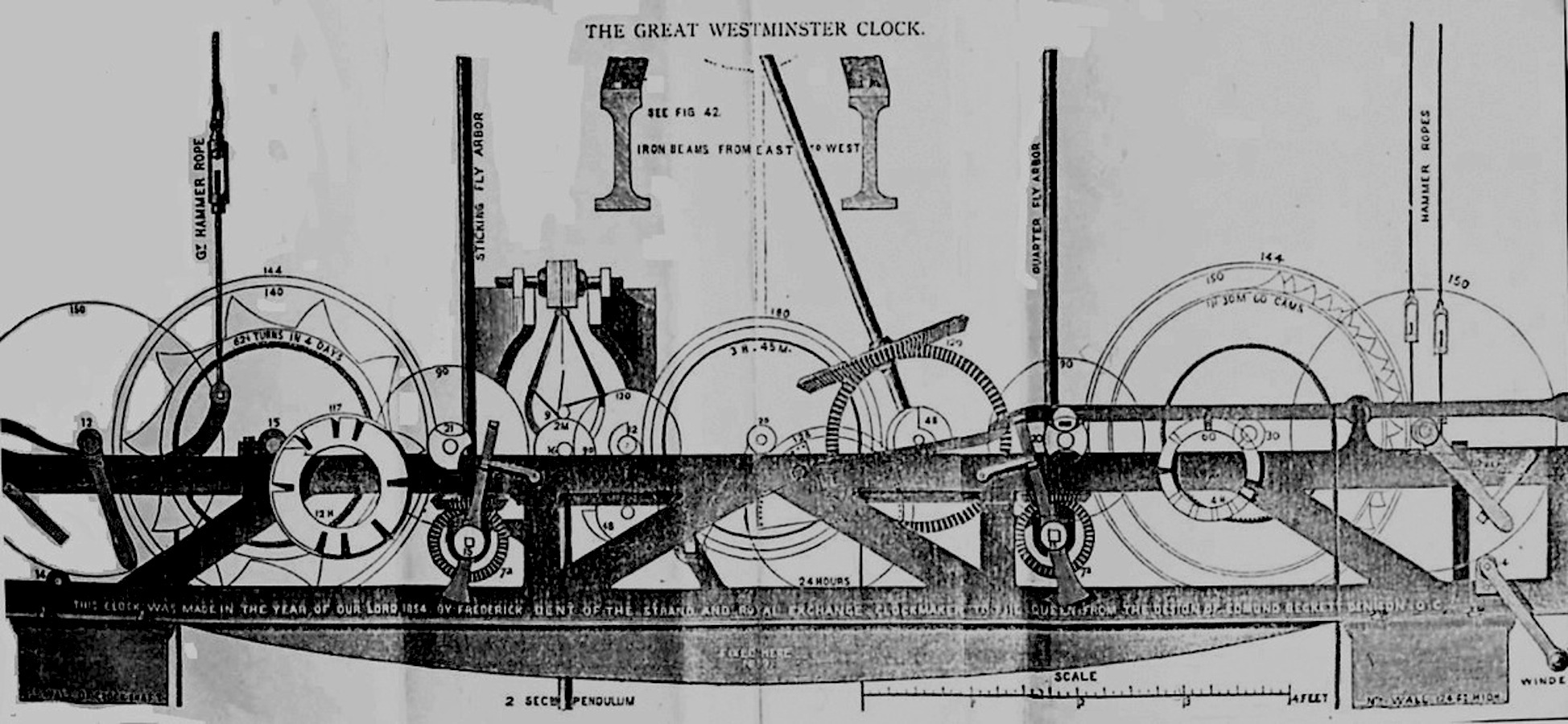
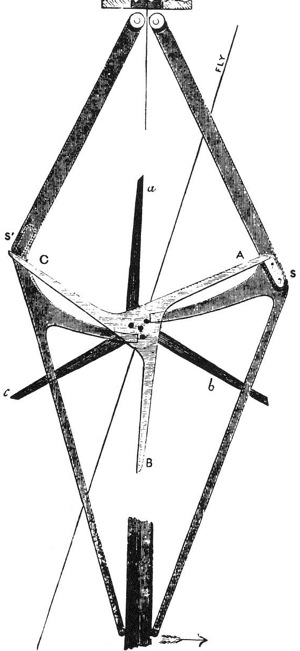 | Denison devised the double three-legged gravity escapement in which the pendulum is kept swinging by two arms, one at each side. The arms are raised alternately and released gently so that the weight of an arm bears on the pendulum rod to give it a gentle push in one direction. The other arm impulses it in the other direction. This prevents pressure on the hands, from wind, snow, or starlings, affecting the pendulum. You can see at at the back of Grimsthorpe's diagram above. |
The escapement was tried out in a smaller turret clock later installed in Cranbrook Parish Church, Kent.
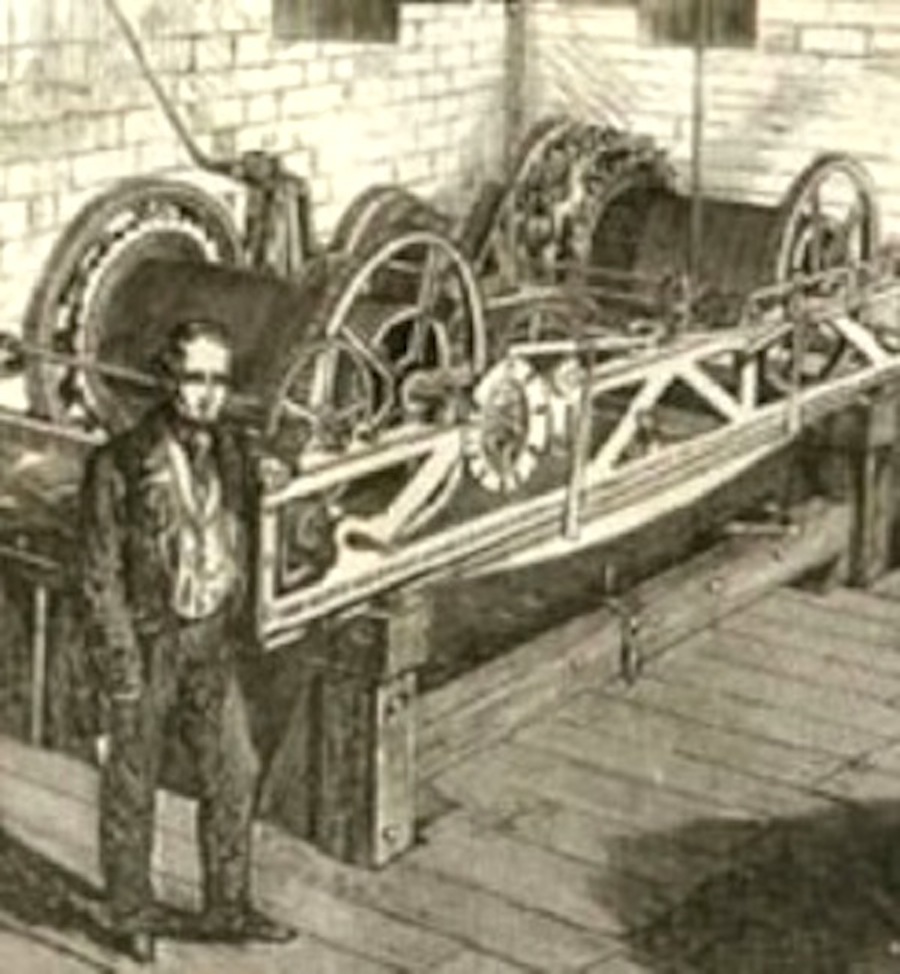 | The clock works were not in the traditional box-shaped iron frame, but on a flat bed, which for the Westminster clock was 16 feet long and 5 feet wide. This was to be the pattern for subsequent turret clocks. | 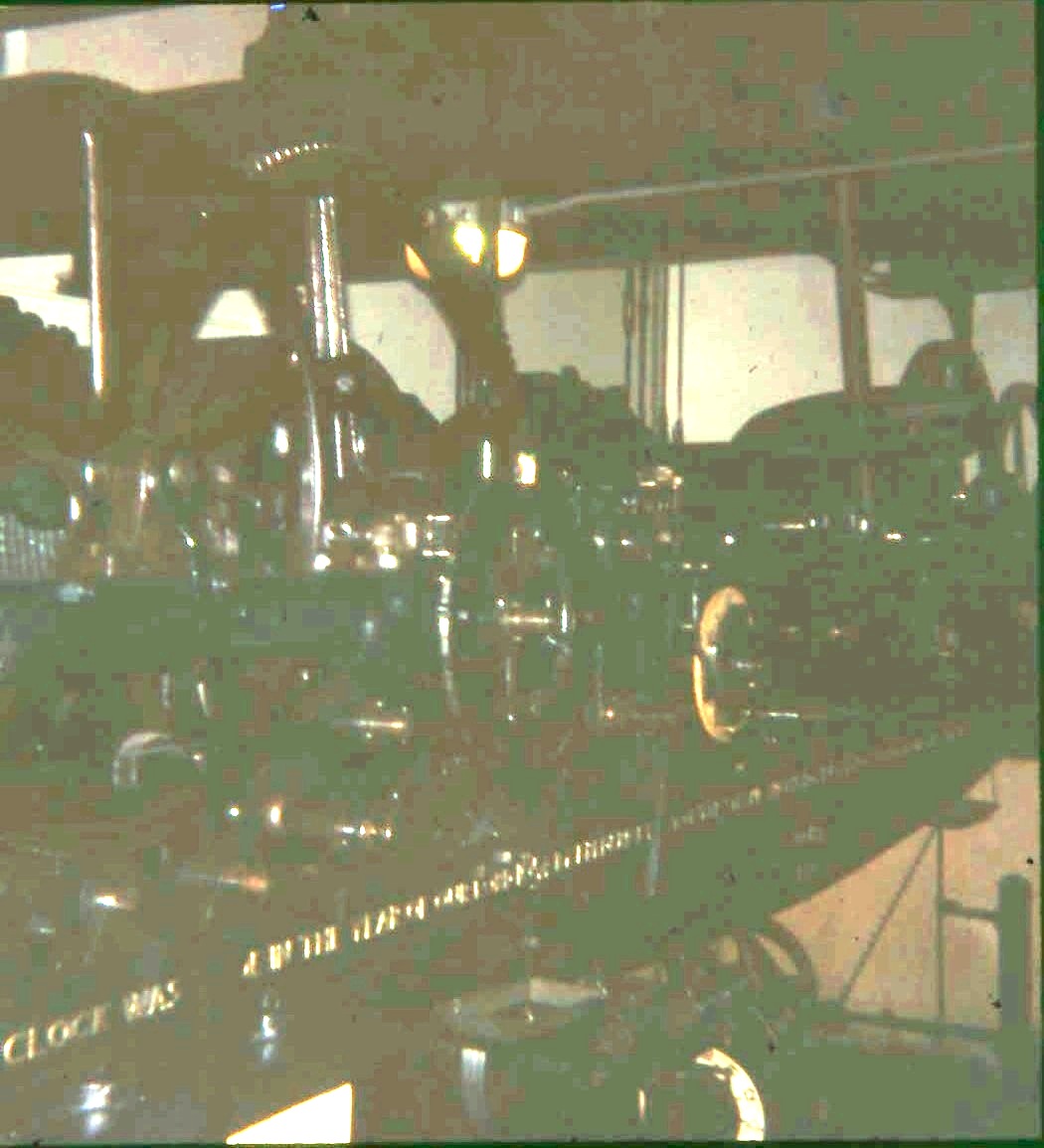 |
Denison was very proud of the rough unpolished finish of the clock works, despite comments that it looked like an old mangle, saying it had considerably cut costs. Unfortunately if the clock had been as highly polished as was usual, it may have lasted longer, and the disaster in July 1976 (soon after my visit - no I didn't touch anything....) when much of the clock was destroyed, is less likely to have occured.
Frederick Dent had a lot more to say to the Board of Works:
"Sir Charles Barry had represented that the stoppage of the works at the tower of which I had complained was in consequence of his having to wait for the Clock. Mr. Denison replied that was impossible; because Sir Charles Barry must know perfectly well, that the Clock could not be fixed until the tower was finished, at least high enough to cover in the clock room; and that the walls were still many feet below the point where the iron plates are to be fixed and on which the clock is to lie, as shewn by the plan and section of the clock-frame and general arrangements send by Mr. Airy and Mr. Denison.""In August last Mr. Airy wrote to tell me that Sir C. Barry required working plans of the clock grame for his guidence in carrying up the tower, and he desired me to send them. I was at a loss to understand what further plans Sir C. Barry could require, and I wrote to Mr. Denison on the subject, as all the drawings have been made by him throughout the business. He replied that Mr. Airy had also written to him and that Mr. Denson had told him, that Sir C.Barry much explain more distinctly what further information he required, beyond that given to him by the drawing above mentioned, or whether he had lost them, as he had previously lost a drawing with reference to the same subject sent to him by Lord Seymour before the contract was made."
Frederick Dent concluded in anger, after what was an extremely lengthy letter:
"After all this recognition of my being the person engaged in completing this contract, and the great expense incurred in it, both by the late Mr. Dent and myself....I must say, with great respect, I am astonished at the Commissioners writing to me, 6 months after I had distinctly informed them I was engaged in completing the work as Mr. Dent's successor, and claiming the right to repudiate the contract altogether."
Federick Dent had Denison to help fight these battles. In fact Denison seemed to want to run the whole thing himself. He was supposed to work together with Airy. By November 1853, Airy had had enough. He wrote:
".....our ideas of the mode of conducting public business are very different, and had at last forced on me the conviction that we cannot with advantage profess to act in concert."
Denison was happy to keep the Astronomer Royal out, but the Board would not accept Airy's resignation.
Denison"s letter of 20th March 1854, follows this up, as well as dealing with the problems of communicating with the architect:
"...When I met Sir Charles Barry at the Office of Works in May 1852 he shewed (his spelling) me a plan of some alterations which he proposed in the walls and staircase; to which I partly assented and partly objected; and as soon as I had the opportunity of considering the effect of them upon the plans of the Clock, as then settled, I wrote to him on the subject. He gave me no copy of the proposed alterations, nor even answered my letter. And consequently, I am now in complete ignorance of the actual or intended arrangements, and even the size, of the place in which the clock is to be fixed for part of his proposal was to diminish the size very considerably.""Mr. Dent, I know, told your Board in his answer to a letter from your secretary last November, that he had himself written to Sir Charles Barry for information with a view to the preparation of the frame, and that he also had received no answer."
"I shall therefore merely go on giving Mr. Dent what I consider the proper directions for the construction of the clock and I shall also advise him not to delay the completeion of it any longer, as he had done hitherto with the view of accomodating it to the progress of the tower."
"And if it afterwards turns out that it cannot be fixed for want of the place to fix it in, or that some extension and expensive alterations are required to adapt the clock and the clock-tower to each other, I think Parliament and the public will have little difficulty in deciding which of the various parties concerned are to blame for the failure, and which are not."
The Attorney General settled the matter in favour of Dent and Denison.
The clock was ready. Airy examined the clock at Dent's factory, and told Sir Benjamin Hll, the First Commissioner of Public Works, that he found it perfectly satisfactory.
It was now time to install the clock and bells.
 But although the clock was ready, the tower was ready, the bells were not. (Picture shows part of the many stairs up to the clock and bells).
But although the clock was ready, the tower was ready, the bells were not. (Picture shows part of the many stairs up to the clock and bells).
As the Reverend Alfred Barry, wrote in his father's biography:
"Much discussion then took place on the question whether the Tower was waiting for the clock, or the Clock waiting for the Tower. In fact neither of this things were true. Both were waiting for the Bells!"
The discussion went on for a year until early in 1856, when Barry, furious at the delay, gave the order to the contractors to fit the roof on the Clock Tower. A drawing drawing of the clock tower with the roof in position and mock dials fitted to allow experiments on the lighting of the Clock Face appeared in the Illustrated London News
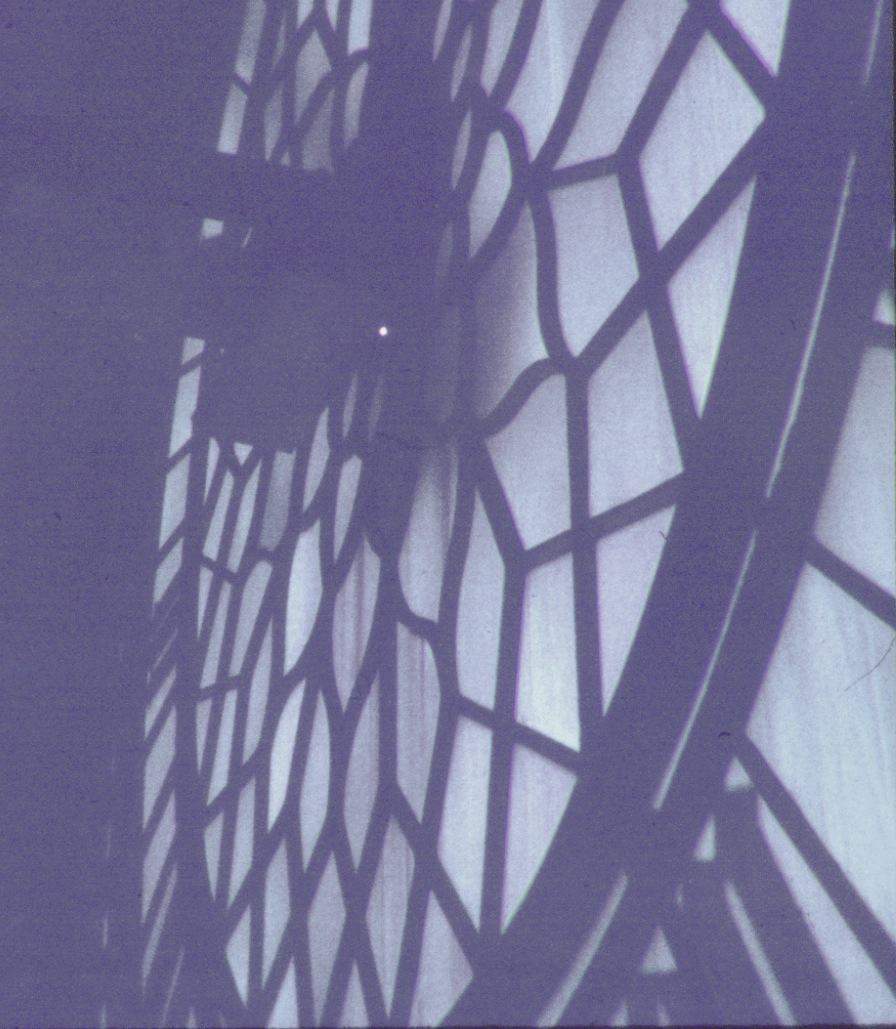 Picture was taken by me behind one of the glass dials in 1975 - it is only when you are standing next to the dial you realised just how very big it is.
Picture was taken by me behind one of the glass dials in 1975 - it is only when you are standing next to the dial you realised just how very big it is.
Barry had originally intended that the bells be hauled up on the outside of the tower and fitted into place. But now the roof was on, the bells and the clock mechanism had to be drawn up inside. The clock could not be fixed into place until the big hour bell and the four smaller bells were hung into position at the top.
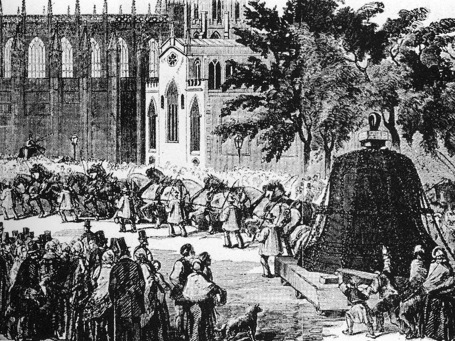 In August 1856, the first big bell was cast in Stockton-on-Tees. Three months, later, in November, it arrived in Westminster. Crowds turned up to watch.
In August 1856, the first big bell was cast in Stockton-on-Tees. Three months, later, in November, it arrived in Westminster. Crowds turned up to watch.
The bell was immediately rigged up on a temporary beam in New Palace Yard, near the bottom of the clock tower, and the trials began.
Eleven months later in October, 1857, the bell cracked from top to bottom. It was furiously smashed to pieces with sledge-hammers and a battering ram.
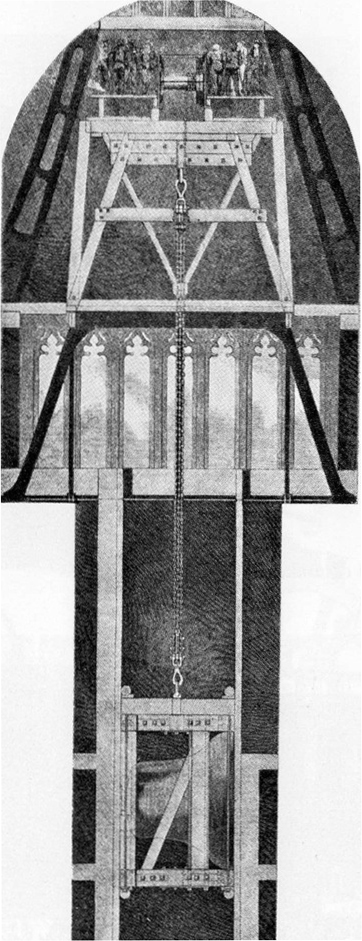 The next bell was a much better casting. It was made at the Whitechapel Bell Foundry by Mears, and the foundry is still there. They had it ready for fitting by October 1858. This was the bell called "Big Ben", which has given its name to the whole famous clock tower.
The next bell was a much better casting. It was made at the Whitechapel Bell Foundry by Mears, and the foundry is still there. They had it ready for fitting by October 1858. This was the bell called "Big Ben", which has given its name to the whole famous clock tower.
The Builder of 16th October 1858, has a cross-section drawing of the upper part of the Clock tower with special scaffolding rigged in the bell-chamber. On the scaffolding is a windlass being turned by a team of 8 men. 4 men to each side of the windlass. The raising of the bell began early in the morning of Wednesday 13th October 1858, and this stalwart team continued without a break through the night until Thursday after, 30 hours non-stop.
Big Ben went up on his side in a special cradle which ran smoothly on wheels up vertical guide gimbers. Progress was about 6 feet an hour, up to 180 feet which was the level of the clock room.
Big Ben was left in the space reserved for the clock mechanism until the next Thursday, the 21st October, when he was turned up mouth down, and hoisted up to the bell-chamber to join the four quarter bells.
As soon as they got Big Ben into place, they sounded a Royal Salute by striking him 21 times with a wooden beetle.
It is not clear how the bell got to be called Big Ben. It was originally called Great Stephen. Then the Illustrated London News refered to it on 9th October 1858, as "Big Ben if such is to be his name?".

The Illustrated London News of 29th January 1859, snidely remarked:
"The Clock Tower stands with its stately grace marred by a patch of unfinished stonework which still clings to its base, while the elaborate dial places and massive hands, which latter are still motionless and point to impossible hours, give to the clock, a spectral and ghastly look much as probably hung about the turret and time-piece of the castle in the fairytale in which all things were struck by that sudden sleep which lasted for a hundred years."
It was the Victorian gothic/mock medieval decoration commissioned from Augustus Welby Northmore Pugin, which was largely to blame for the building looking like something out of a gothic romance or horror story. A compromise by Barry who designed a modern building - but with all the, at that time, trendy, fairytale gothic embellishment desired both inside and out, supplied by Pugin. As the look was fashionable Pugin was in great demand for this work. By 1851, his health and sanity broke down and he died aged 40 in 1852 apparently of syphilis.
Progress was being made - the Illustrated London News reported on 26th February 1859:
"It is understood that the interior of the Clock Tower is approaching completion. the works are all ready for erection. the arrangements for striking the hours on the great bell are also completed and those for ringing out the chimes on the smaller bells are in a forward state."
But slowly. The Times 23rd April, 1859:
"Our readers, we are sure, will be glad to learn that the Great Clock of Westminster is at last progressing towards completion. In saying this we by no means intend to convey the impression that the Clock will soon be going, or that a considerable interval may not elapse before it is completed, or even that it will ever be completed at all!"
The article goes on to describe a hydraulic clock-winding system which was beng considered for installation since it took two men 18 hours non-stop, every third day to wind the clock up.
The clock winders had another problem. According to a paper "Results of Eudiometrical Experiments" in House of Commons Paper No.442 of 1858, the air at the top of the tower in the clock-room was worse even than the air in the Commons Chamber. The curtains in the Commons Chamber had been soaked in the deodorant mentioned earlier, but an analysis of the dust on the floor on the chamber showed most of it was horse poo, trodden in as members left their horse drawn carriages parked outside. Not all the bad smells came from without.
The evil miasma in the clock room was due to the new ventilation system. Goldsworthy Gurney had connected his clock tower escape hatch to the main Victoria sewer, so that the clock tower would not only draw off the flatulence and other pongy stale air from the two Chambers, it would also siphon off the pestilential sewer gas from the whole of Victoria and Westminster. The offensive effluvia emerged from the clock tower through holes just beneath the face of the clock. Gurney reported on 8th January 1855, that the amount of effluvia passing through was 25,000 cu.ft. per hour.
A coke fire was lit to speed the bad air up to the clock face and out into the skies of Westminster. One day coal gas escaped from the gas mains into the sewer. There was an explosion.
Work was also held up by the inadequacy of the frame. On 2nd March 1859, Denison reported:
"The bells were fixed in the Clock tower but they are let down a little to enable some pieces to be put in the frame of the nature of diagonal braces to strengthen it against the shake caused by the blow of the great hammer.""The frame was not designed by me, though I approved of the design generally I expressed some doubt whether diagonal bracing would not be required to resist the blow on the great bell."
"The clock is not fixed because the clock room will not be ready for it until the weight-shaft is properly covered over, the the pendulum room constructed in it, and the enclosed passage made through the airshaft, to give access from the clock room and the west dial works. This must also be made of iron because the airshaft is in fact a chimney; it must be made carefully so as to be airtight, or else the fumes of the ventilating fire will come into the clock room. It is bad enough to have them discharged into the bell chamber, a thing which I suppose exists no where else in the world."
The shaft is situated behind the clock works.
Meanwhile the public were getting impatient: Punch, 5th May 1859: "That idle clock at Westminster which may well hold its hands before its face for very shame, had cost the Nation the pretty little sum of £22,057. We never knew a richer illustration of the homely truth that Time is Money".
When the clock actually did begin to tick, the Press ignored the event, perhaps because, quite rightly as it turned out, they did not expect that state of affairs to continue.
A letter in The Times of 13th July, 1859, complained that the noise from Big Ben was rather a disappointment. An official report had said its note was pure enough but complained of "the funereal slowness of its strokes".
This seems a good place to put in the email received 23rd August 2013, from Peter Vince, who has given permission for it to be used. As it contains very interesting information about the ironwork for the massive clock dials and the roof.
Big Ben and the history of the clock tower at the Palace of Westminster."I have just read your absorbing article on the above item. I have for more years than I care to remember had a personal interest in the history of the Great Clock, and have collected much technical and detailed information over that time. But for the first time, to my knowledge, an historic account of the building and its contents in a form that is both informative and enjoyable to read....Thank you. In case you might be interested, my own curiosity was fueled by the fact that my Gt-Gt Grandfather, Robert Vince, a Master Blacksmith from Downham Market, Norfolk, came to London to work for a company in the City responsible for making the dials and original hands for the Great Clock. I struggled for a long time, with help from people at the Parliamentary Archives, to find the name of the company but without success. However, I eventually received the following email from Dr. Mark Collins:
"Dear Mr. Vince, "Sadly, like Mr. Dent, Robert never lived to see the real item installed and working, but we are still proud descendants." Peter Vince."
|
Which leads us on to the problems with the huge clock hands needed for dials this size.
The clock had only been going for one month, when it was found that the hands, designed by and insisted on by Barry, were too heavy.
Barry was furious when Denison insisted on replacing Barry's beautiful ornate and guilded clock hands with plain but functional hands designed by himself.
Barry had stated originally:
"I have no wish whatsoever, to identify myself in any respect with the works of the Clock, over which I have never had any control, I beg to suggest the hands should be provided under the direction of Mr. Denison."
This did not stop Barry arguing that his clock hands were perfectly all right, and getting his clerk of the Works to stop Dent's men taking away his hands to replace them with Denison's more practical design. A battle took place at the clock tower between Barry's men and Dent's men.
Barry sent detailed diagrams to try to prove the effectiveness of his clock hands. He asked for one of the original hands to be left on to prove it was satisfactory. He insisted that one of the hands be weighted in a public demonstration. This was performed on the 29th September 1858, and Denison was proved right.
It seemed that it only remained to clean up the dust made in installing the gas pipes for the illumination of the glass dials, 24 feet (7.3152 metres) across; the regulation of the clock itself; and the repair of the hands of the south dial, the last to be dealt with.
Frederick Dent, by now in very poor health, presented his bills for payment on the completion of the clock.
Then Big Ben was found to have developed a great crack! You can still see it. It did not appear to affect the tone too much, so the bell was turned round and a lighter hammer fitted. The huge crack can be easily seen, but after 150 years, the bell which was to become an iconic symbol of the Nation and its defence against its enemies, is still ringing out the hours.
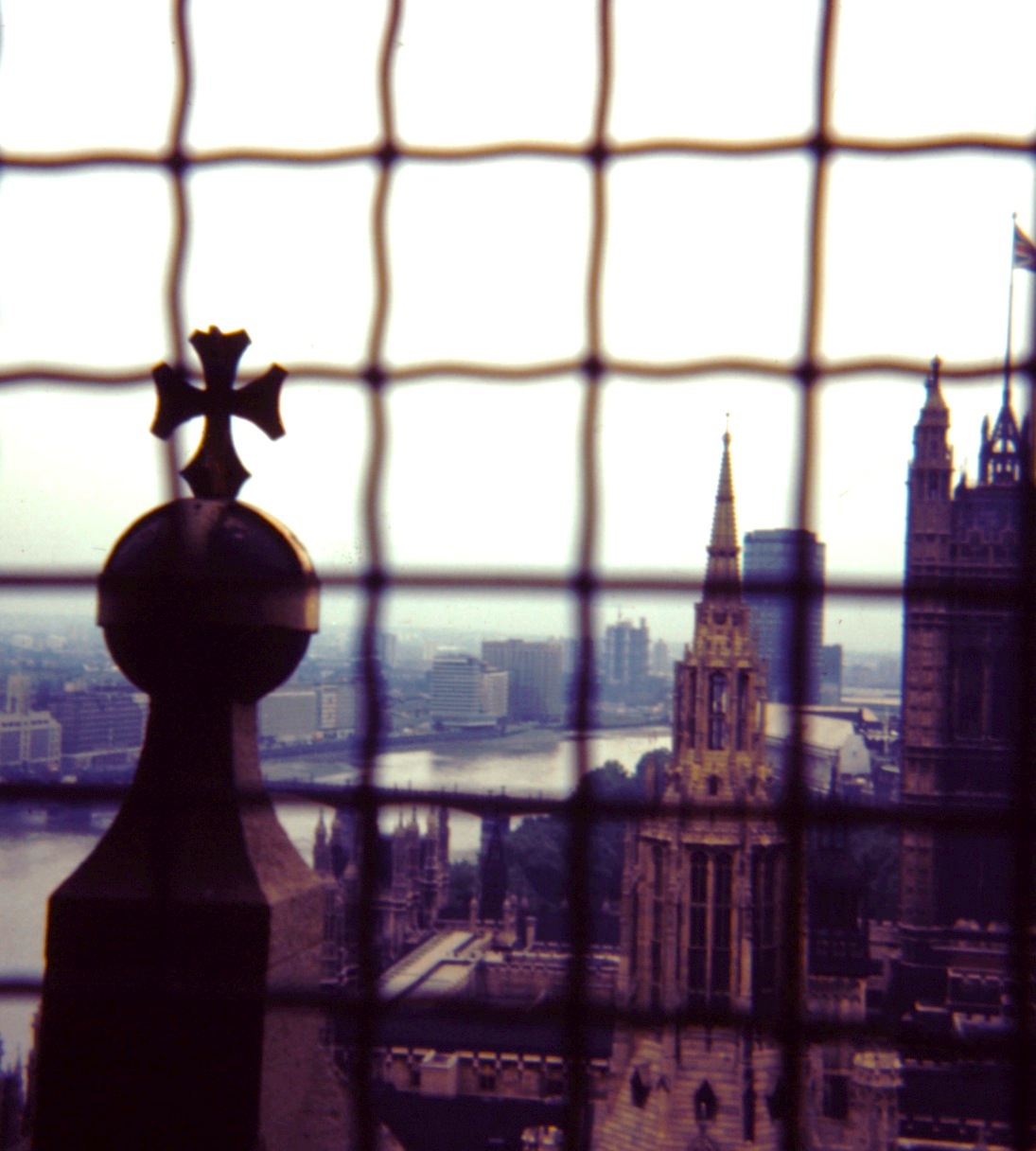
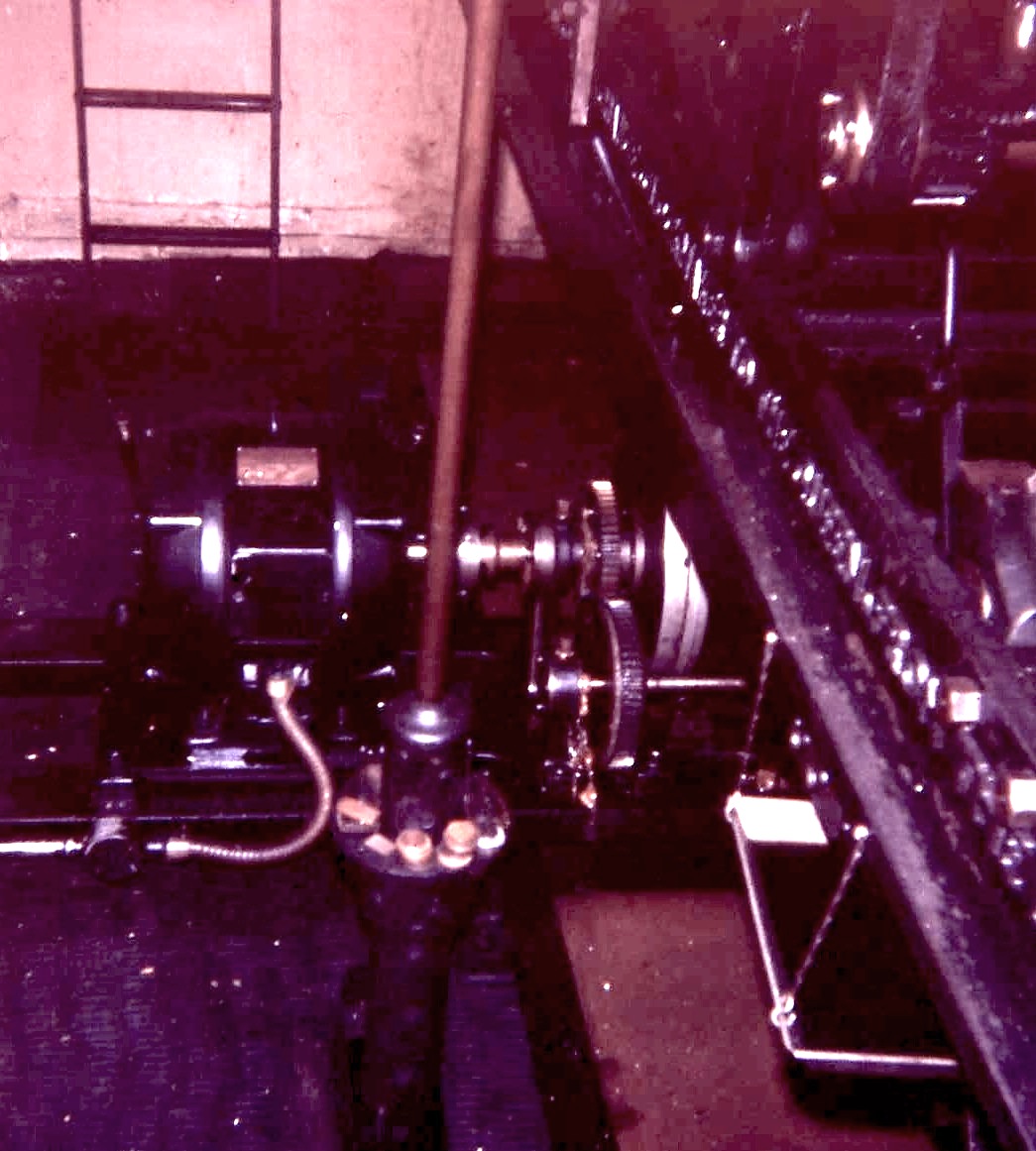 I went up to see the clock in 1975, as part of the research I was doing. Some years earlier, in 1970, I had written about the Hampton Court Clock, and had been commissioned to write the booklet. Now I was researching a thesis, later published as an article in 1980 in Clocks magazine. This picture on left, shows the view I photographed from the platform with Big Ben. When it is striking the hour it is best for the sake of your ears, to be out by the bell. The picture I took of the view from the other side, shows how much London has changed since 1975 and how much older I am. So I have not put it in. The picture on the right shows the pennies placed on the pendulum to regulate it. Although these have long ceased to be legal currency, they are still kept for the purpose as they are used to using old pennies, but you could really use anything, I was told, paperclips, or anything you can put there.
I went up to see the clock in 1975, as part of the research I was doing. Some years earlier, in 1970, I had written about the Hampton Court Clock, and had been commissioned to write the booklet. Now I was researching a thesis, later published as an article in 1980 in Clocks magazine. This picture on left, shows the view I photographed from the platform with Big Ben. When it is striking the hour it is best for the sake of your ears, to be out by the bell. The picture I took of the view from the other side, shows how much London has changed since 1975 and how much older I am. So I have not put it in. The picture on the right shows the pennies placed on the pendulum to regulate it. Although these have long ceased to be legal currency, they are still kept for the purpose as they are used to using old pennies, but you could really use anything, I was told, paperclips, or anything you can put there.
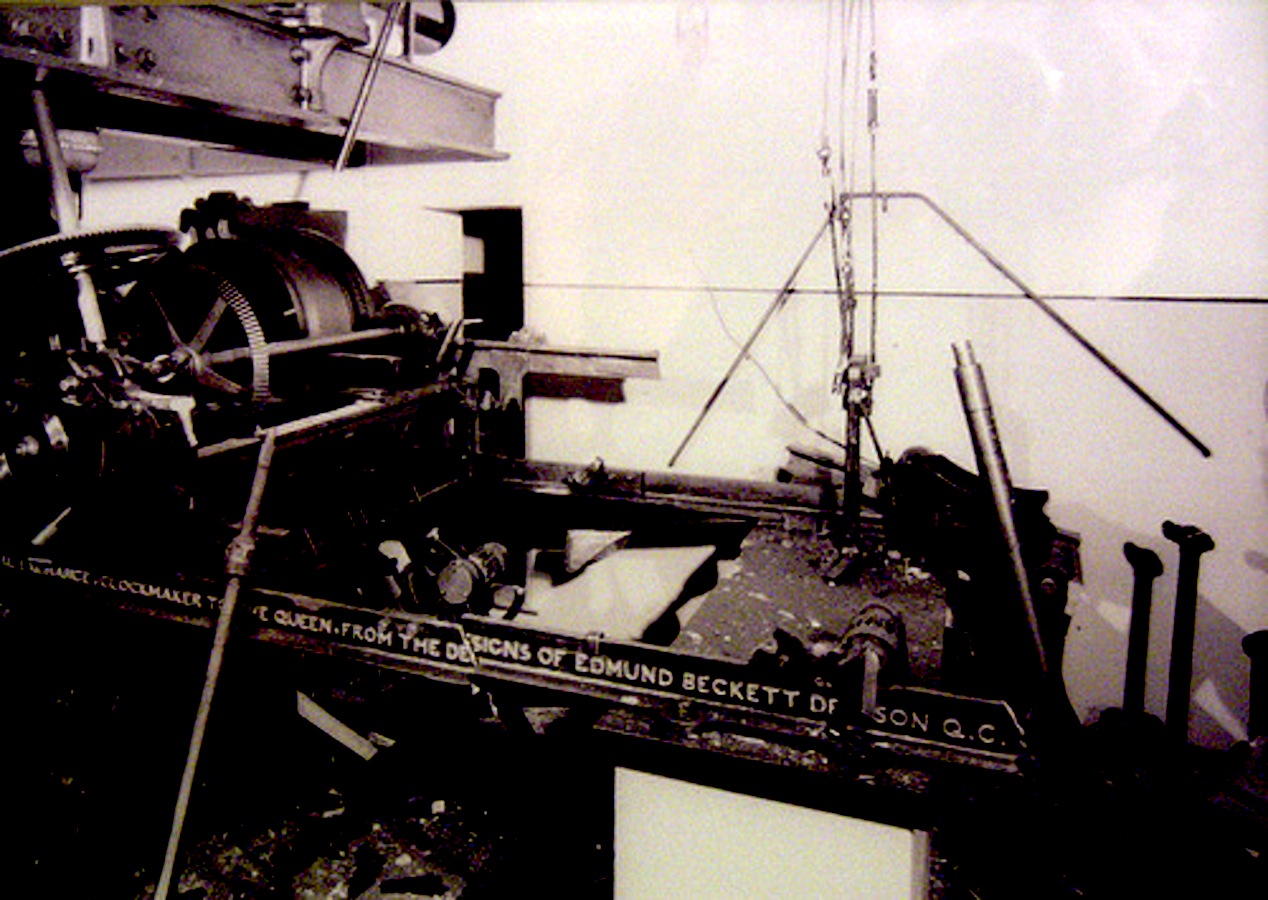
I was lucky to have seen the clock then, as it turned out to be the last chance of seeing the original works, for just after, in 1976, it smashed itself to pieces.
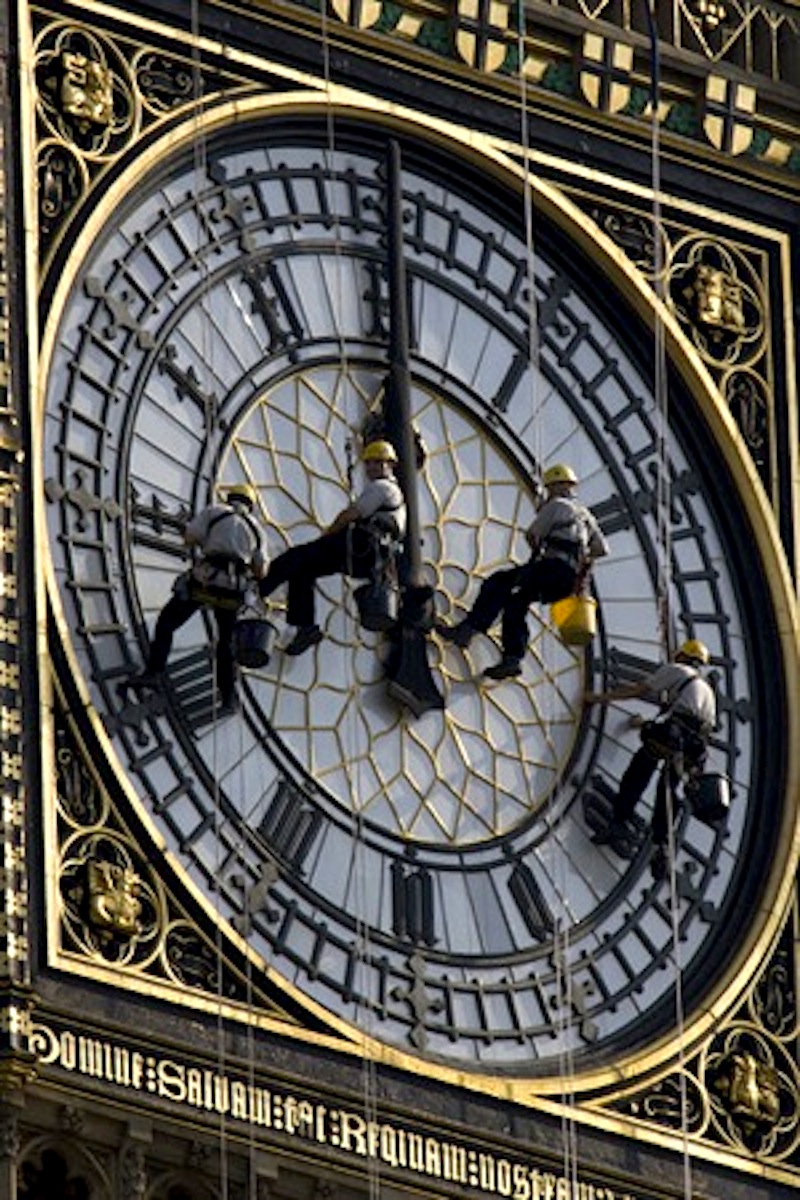 | This picture shows the clock dial being scrubbed up in 2007, ready for the clock's 150th birthday. One of the men hanging in space cleaning the dial is Stephen White who helped me recently with an update on the clock tower. |
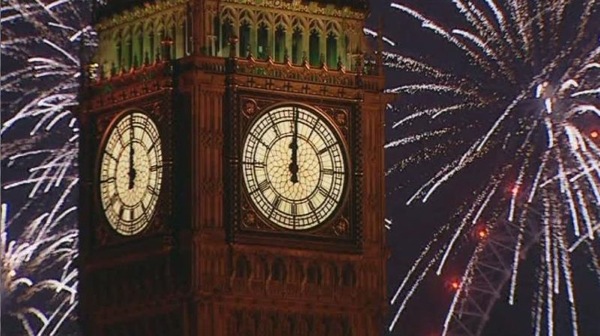 | And this picture shows the clock celebrating - as it does - the new year - its 150th this time 2009. |
| Big Ben's website | |
| 2012, Big Ben leaning over more. | |
| Pictures of the clock at 150 years old. | |
| Whitechapel Bell Foundry - makers of Big Ben. | |
| History of Houses of Parliament. | |
| Renovating Big Ben | |
| Free poster to download |
The Triumphs of Big Ben by John Darwin, 1986
Mid-Victorian Masterpiece by Barnett Cocks, 1977
A Rudimentary Treatise on Clocks, Watches & Bells for Public Purposes, by Edmund Beckett, Lord Grimsthorpe (reprinted from 8th edition 1903).
and Queen Elizabeth now has its ventilation shaft named after her.
by Heather Hobden |  |
Copyright Heather Hobden and the Cosmic Elk